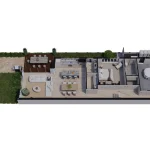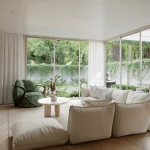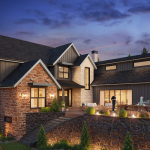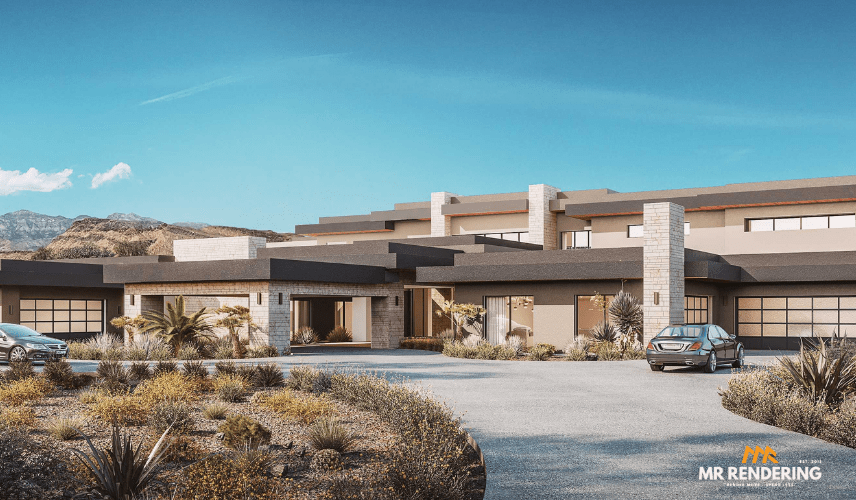
A 3D rendering of a house is not just an artistic visual; it’s a mission-critical sales tool that directly impacts your project timeline and marketing ROI. For a real estate project manager, a delay in receiving these assets is a direct threat to hitting sales targets. The process often feels like a black box, leaving you to hope the visuals arrive in time for your brochures to be printed and your marketing campaigns to launch.
This guide is designed to change that experience. It’s not a generic list of factors that affect rendering time. Instead, it’s a project manager’s playbook that provides practical control over the visualization process. We will show you how to actively manage the seven critical levers that can accelerate timelines, eliminate bottlenecks, and transform the creation of your 3D rendering of a house from a source of stress into a predictable, streamlined process.
1. From Vague Brief to “Speed Brief”: Your Most Powerful Tool
The single greatest cause of delays happens before a 3D artist even touches your project: an incomplete or ambiguous brief. Every question the studio has to ask is a delay. Every assumption they make is a potential revision down the line.
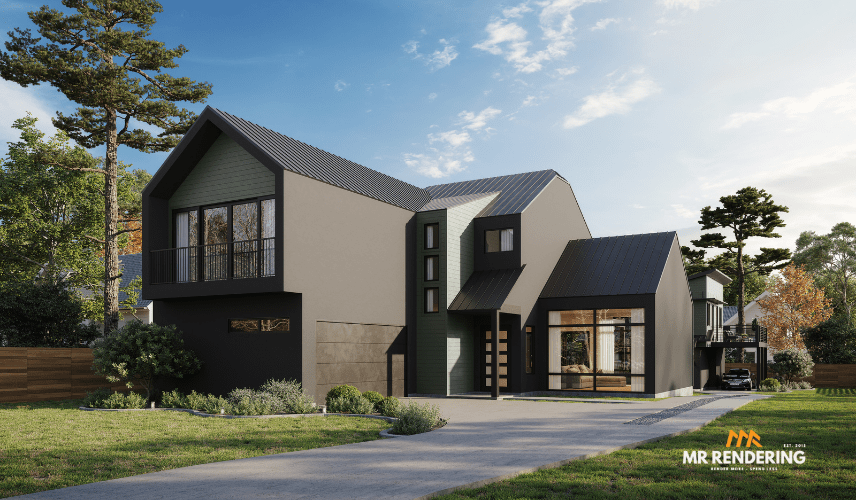
When you describe a project as “luxurious,” the artist’s interpretation may not match your vision, leading to costly delays. A better approach is to be clear from the start. This is especially important for the 3D rendering of a house when the details matter most.
Here’s speed brief how to ensure your vision is understood and executed correctly for your next 3D rendering of a house project:
- Create a Visual Mood Board: Go beyond words and provide visual examples of your desired aesthetic. This includes specific colors, textures, lighting, and furniture styles. A Pinterest board is a perfect tool for this.
- Prioritize Your Key Shots: Not all renders are equal. Clearly identify the “hero shots” for your marketing campaign. Let the studio know which views are most important so they can focus their initial efforts where it counts.
- Provide a Detailed Checklist: If specific materials, finishes, furniture, or brand-name appliances are crucial to your design, provide a clear list with images and links to avoid miscommunication and revisions.
Bottom Line: A single hour spent creating a “Speed Brief” can easily save you a week of back-and-forth communication and revisions.
2. Match the Medium to the Mission: Static vs. Tour vs. Animation
Choosing the final format of your visual isn’t just a creative decision; it’s a strategic one that has a massive impact on the timeline. Aligning the deliverable with your specific marketing goal is key.
- Static Renderings (The Workhorse): This is a single, high-resolution image. It’s the fastest and most cost-effective option, perfect for print brochures, website listings, and social media posts.
- Timeline: Typically a few days to a week for the first draft.
- Interactive 3D Virtual Tours (The Immersive Experience): This requires the studio to model and detail the entire space, not just what’s visible in one shot. It’s significantly more time-intensive but offers a powerful, engaging tool for potential buyers.
- Timeline: Can take several weeks, as every corner of the property must be marketing-ready.
- 3D Animations (The Hollywood Trailer): This is the most complex and time-consuming format. It’s not just a render; it’s a short film that involves storyboarding, camera path planning, and rendering thousands of individual frames.
- Timeline: Plan for a multi-week or even multi-month production schedule. This is for a flagship marketing campaign, not a last-minute request.
The PM Solution: Map your visual assets directly to your marketing timeline. Need visuals for an Instagram campaign next week? Order static renderings. Planning a major launch event in three months? Start the conversation about a CG animation now. Never order a complex virtual tour when a simple, beautiful 3D rendering of a house will achieve the same immediate sales goal.
3. The “Just One More Angle” Trap: Defining Scope from Day One
Scope creep is a timeline killer, and in visualization, its most common form is the “just one more angle” request. After the initial views are delivered, someone on the sales team might decide they need a shot of the master bathroom. This seemingly small request can cause significant delays.
- The Problem: The artist optimized the initial 3D rendering of a house for the agreed-upon views. The model behind the “camera” might be unfinished. To create the new angle, they may have to go back to the modeling and texturing phase, effectively pausing all other progress.
- The PM Solution: Create a comprehensive “Shot List” at the very beginning of the project, as part of your brief. Think like a film director and list every single view your marketing and sales teams will need.
- Exterior: Front facade, backyard/pool area, aerial view.
- Interior: Kitchen, living room, master bedroom, master bathroom, unique selling point (e.g., home office, wine cellar).
- Getting sign-off on this list from all stakeholders before the project begins ensures everyone is aligned and prevents disruptive last-minute additions.
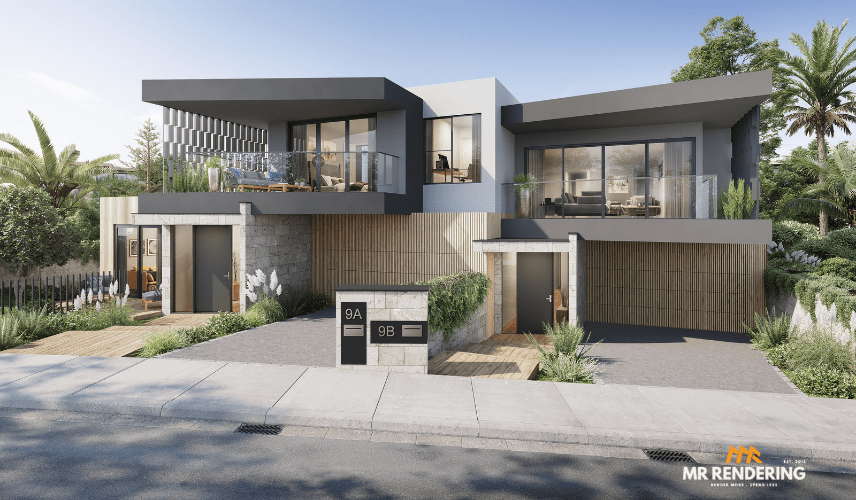
Modern Duplex Design: A Striking 3D Rendering Houston Project
4. The Revision Bottleneck: How to Give Feedback That Accelerates, Not Stalls
Revisions are a necessary part of the creative process, but the way feedback is delivered can either streamline the project or send it into a death spiral of endless tweaks.
- The Problem: You send the draft to five people on your team. You forward five separate emails with conflicting feedback to the studio (e.g., the sales manager wants a warmer light, but the marketing director wants it brighter). The artist is now paralyzed, waiting for you to provide a single source of truth.
- The PM Solution:
- Consolidate All Feedback: Your most important role during revisions is to be the central point of contact. Collect feedback from all stakeholders and consolidate it into a single, unambiguous document. Use a tool like Markup Hero or simply annotate a PDF with clear, concise notes.
- Distinguish “Tweaks” from “Changes”: Understand the timeline impact of your requests. Changing the color of a cushion is a minor tweak (hours). Moving a wall or swapping the entire kitchen layout is a major design change that could send the project back to the modeling stage (days or even weeks). Batch your feedback and be clear about priorities.
5. The Custom vs. Catalog Trade-Off: A Strategic Choice for Speed
Every object in your 3D rendering of a house has to be created or sourced. Your decisions here directly impact the modeling time.
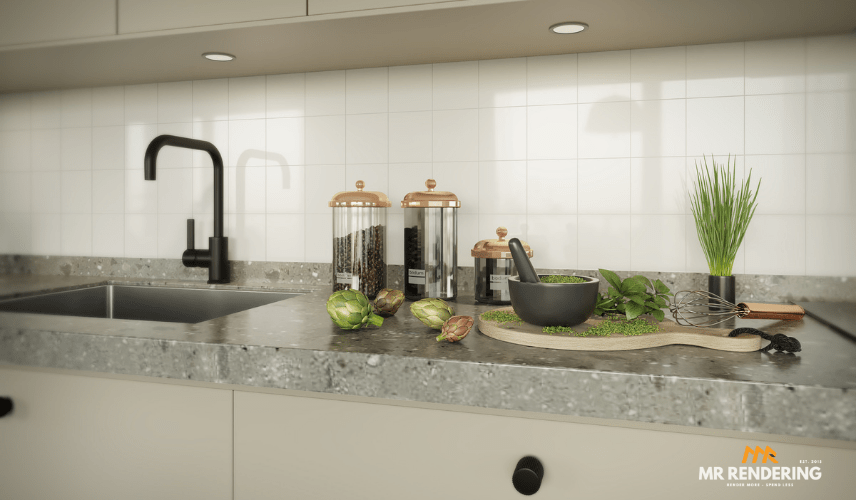
- The Problem: You insist on a specific, custom-designed chaise lounge that is a central feature of the living room. The artist must now spend two days meticulously modeling that single piece of furniture from scratch based on photos.
- The PM Solution:
- Leverage the Studio’s Library: Professional studios maintain vast libraries of high-quality, pre-made 3D models of furniture, decor, and plants. For secondary items, trust the studio’s designers to populate the space with assets from their library. It’s faster and often looks just as good.
- Provide Existing 3D Assets: If the project’s architect or interior designer has already created 3D models (in formats like RVT, FBX, DWG), providing these to the visualization studio is the single fastest way to accelerate the project. This allows them to bypass the foundational modeling stage entirely.
6. The Environment Matters: Photo-Matching for Exterior Renders
For an exterior 3D rendering of a house, you’re not just commissioning a model of the building; you’re commissioning its world. Building a realistic digital environment from scratch is incredibly time-consuming.
- The Problem: You need 3D rendering of a house in a specific suburban setting. The artist must digitally model the surrounding trees, neighboring houses, sidewalks, and streets to create a believable context.
- The PM Solution: Use photo-matching. This technique involves taking a high-resolution photograph of the actual site from the exact angle the final render will have. The 3D model of the new house is then skillfully integrated into the real-world photo. The result is hyper-realistic, contextually perfect, and dramatically faster to produce than a fully CGI environment.

7. The Ultimate Accelerator: A Studio’s Workflow
You can have the perfect brief and the simplest project, but if the studio you hire is disorganized, you will face delays. A professional studio’s internal workflow is your project’s safety net.
- The Problem: Communications are lost in long email chains, feedback is misinterpreted, and there’s no single person you can contact for a clear update on progress and deadlines.
- The PM Solution: During your due diligence, ask about their process.
- Dedicated Project Manager: Will you have a single point of contact responsible for your project’s timeline?
- Centralized Platform: Do they use a project management portal (like Basecamp, Asana, or a custom dashboard) where all files, feedback, and communication are stored?
- Clear Revision Rounds: Does their contract clearly state how many rounds of revisions are included and what the process is for providing feedback?
Choosing a studio with a robust, transparent workflow is as important as choosing one with a great portfolio.
Conclusion: You Are in the Driver’s Seat
The timeline of your 3D rendering of a house is not a passive waiting game. It’s an active process that you, the project manager, have significant power to influence.
By investing time upfront in a clear brief, making strategic decisions about scope, and managing feedback efficiently, you can eliminate guesswork and take control. The final, critical step is choosing a well-organized partner who understands the pressures of your project launch. At Mr. Rendering (explore more in out portfolio here), we’ve built our entire workflow to be that partner. We provide not just stunning visuals, but a clear, predictable, and collaborative process designed to ensure your most crucial sales assets are delivered exactly when you need them.
Let us help you guarantee a successful and profitable project launch.

Content Writer, Copy Writer
As a passionate content writer, Hoang Phuong specializes in creating high-quality, compelling narratives around 3D rendering and architectural visualization. Leveraging deep industry knowledge, Phuong excels at delivering information that is not only clear and creative but also genuinely inspiring, fostering stronger connections with clients and fellow professionals alike.



